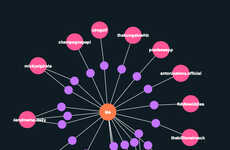
The Virtual Wars Hacktivism Infographic Reviews the New Powerful Weapon
Rebecca Byers — March 30, 2012 — Pop Culture
FrugalDad.com's The Virtual Wars Hacktivism infographic is a comprehensive review of the new powerful online weapon defined as "the nonviolent use of legal and/or illegal digital tools in pursuit of political ends." Recent examples of hacktivism listed in the infographic include Anonymous' successful attempt to crash the F.B.I. website and the Syrian government's, hacking its opposition online.
According to The Virtual Wars infographic, the first ever act of hacktivism took place in October of 1989, which involved the WANK (worms against nuclear killers) worm and was in protest of nuclear armament. The informative graph also include an analysis of the different types of hacking, hacking statistics and the top five countries hackers reside in, with 66.1% living in the United States.
According to The Virtual Wars infographic, the first ever act of hacktivism took place in October of 1989, which involved the WANK (worms against nuclear killers) worm and was in protest of nuclear armament. The informative graph also include an analysis of the different types of hacking, hacking statistics and the top five countries hackers reside in, with 66.1% living in the United States.
Trend Themes
1. Hacktivism - The rise of hacktivism poses disruptive innovation opportunities for cybersecurity firms to develop advanced defense mechanisms against digital vigilantism.
2. Digital Tools - The increasing use of legal and illegal digital tools for political activism creates opportunities for software developers to create innovative tools that protect user privacy and online freedoms.
3. Government Response - The growing prevalence of hacktivism calls for disruptive innovation within governments to establish effective policies and strategies to prevent cyber attacks and protect critical infrastructure.
Industry Implications
1. Cybersecurity - The cybersecurity industry can capitalize on the trend of hacktivism by providing advanced threat detection and prevention solutions to counter cyber attacks.
2. Software Development - The software development industry can explore opportunities to create encryption technologies and secure communication platforms that protect user privacy in the face of growing digital vigilantism.
3. Government Services - The government services industry can leverage the trend of hacktivism by investing in robust cybersecurity infrastructure and training to combat cyber threats to national security.
3.4
Score
Popularity
Activity
Freshness























